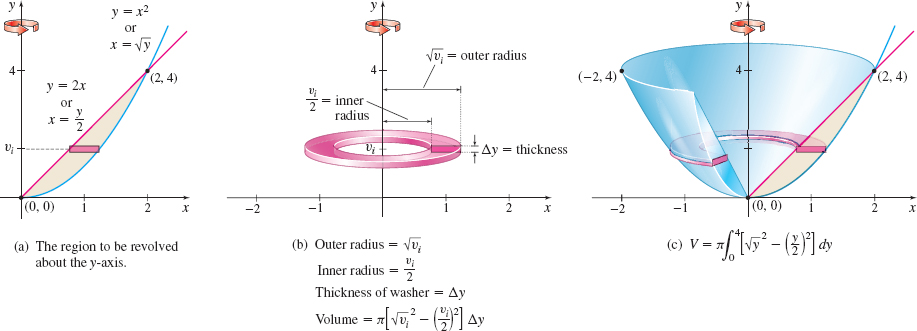EXAMPLE 5Using the Washer Method: Revolving About the \(y\)-Axis
Find the volume \(V\) of the solid of revolution generated by revolving the region enclosed by the graphs of \(y=2x\) and \(y=x^{2}\) about the \(y\)-axis.
Solution We begin by graphing the two functions. See Figure 25(a). The \(x\)-coordinates of the points of intersection of the graphs satisfy the equation \begin{eqnarray*} 2x &=&x^{2} \\[2pt] x^{2}-2x &=&0 \\[2pt] x(x-2) &=&0 \\[2pt] x &=&0\quad \hbox{or}\quad x=2 \end{eqnarray*}
The points of intersection are \((0,0)\) and \((2,4)\). The limits of integration are from \(y=0\) to \(y=4\).
Since the solid is formed by revolving the region about the \(y\)-axis from \(y=0\) to \(y=4\), we write \(y=2x\) as \(x=\dfrac{y}{2}\) and \(y=x^{2}\) as \(x=\sqrt{y}\). The outer radius is \(\sqrt{y}\) and the inner radius is \(\dfrac{y}{2}\).
As Figure 25(b) illustrates, if we partition the \(y\)-axis, the volume \(V_{i}\) of a typical washer is \begin{equation*} V_{i}=\pi \left[ \left( \hbox{Outer radius}\right) ^{2}-\left( \hbox{Inner radius}\right) ^{2}\right] \Delta y=\pi \left[ ( \sqrt{v_{i}}) ^{2}-\left( \frac{v_{i}}{2}\right) ^{2}\right] \Delta y \end{equation*}
The volume \(V\) of the solid of revolution shown in Figure 25(c) is \begin{eqnarray*} V&=&\pi \displaystyle \int_{0}^{4}\left[ ( \sqrt{y}) ^{2}-\left( \frac{y}{2}\right) ^{2}\right] {\it dy}=\pi \displaystyle \int_{0}^{4}\left( y-\frac{y^{2}}{4}\right){\it dy}\\[4pt] &=&\pi \left[ \frac{y^{2}}{2}-\frac{y^{3}}{12}\right] _{0}^{4}=\frac{8\pi }{3}\hbox{ cubic units} \end{eqnarray*}


